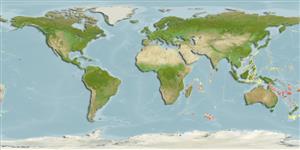>
Anguilliformes (Eels and morays) >
Ophichthidae (Snake eels) > Ophichthinae
Etymology: Ophichthus: Greek, ophis = serpent + Greek, ichthys = fish (Ref. 45335); genie: Named for Eugenia B. Böhlke.
Eponymy: (See Böhlke, EB & JE) (Ref. 128868), visit book page.
More on author: McCosker.
Environment: milieu / climate zone / depth range / distribution range
Ecología
marino batidemersal; rango de profundidad 215 - 500 m (Ref. 31795). Deep-water
Indo-Pacific: New Caledonia and the Maldives.
Tamaño / Peso / Age
Maturity: Lm ? range ? - ? cm
Max length : 33.7 cm TL macho / no sexado; (Ref. 31795)
Minimum depth reported taken from Ref. 86942.
Life cycle and mating behavior
Madurez | Reproducción | Puesta | Huevos | Fecundidad | Larva
McCosker, J.E., 1999. Pisces Anguilliformes: deepwater snake eels (Ophichthidae) from the New Caledonia region, Southwest Pacific Ocean. p. 571-588. In A. Crosnier (ed.) Résultats des Campagnes Musorstom, Volume 20. Mémoires du Muséum national d'Histoire naturelle: 180. (Ref. 31795)
IUCN Red List Status (Ref. 130435: Version 2024-1)
Threat to humans
Harmless
Human uses
Pesquerías: sin interés
Herramientas
Special reports
Download XML
Fuentes de Internet
Estimates based on models
Preferred temperature (Ref.
123201): 5.7 - 9.2, mean 7.4 °C (based on 16 cells).
Phylogenetic diversity index (Ref.
82804): PD
50 = 0.5000 [Uniqueness, from 0.5 = low to 2.0 = high].
Bayesian length-weight: a=0.00091 (0.00039 - 0.00215), b=2.99 (2.79 - 3.19), in cm total length, based on LWR estimates for this (Sub)family-body shape (Ref.
93245).
Nivel trófico (Ref.
69278): 3.8 ±0.6 se; based on size and trophs of closest relatives
Resiliencia (Ref.
120179): Bajo, población duplicada en un tiempo mínimo de 4.5-14 años (Assuming tmax>10).
Fishing Vulnerability (Ref.
59153): Low vulnerability (24 of 100).
